
Above 25 year old Kasatka swims with her calf Nakai born by artificial insemination at Sea World of California. Since marine parks can no longer take orcas from the wild many parks have set up captive breeding programs. Sea World has the most successful captive breeding program in the world with more then 10 calves born in their parks in Florida, California and Texas. Although there is photos of wild orcas with their calves there in no known live footage of a wild orca giving birth. Baby orcas is a page mostly about captive orcas and there mothers but with information about wild orcas as well along with about a hundred photos of young orcas and there moms.
Birth by Artificial Insemination
At Sea World of California on September 1st, 2001 a 25 year old orca named Kasatka was the first orca in the world to give birth through artificial insemination. Her calf named Nakai is a healthy male orca. The father of Nakai is a male orca named Tilikum who lives at Sea World of Florida. The breeding cycle of an orca is about every 3 years. Only July 9th, 1991 Kasatka gave birth to her first calf Takara. Sea World has the most successful killer whale breeding program in the world. Mixing gene pools is essential for the orcas health and now through artificial insemination that process is easier and better for the orcas being they dont have to transport a male from one park to the next. Transporting can cause stress for the animals. Sea World reports that it only took 20 minutes to train Kasatka for the artificial imsemination process and that it was very easy. Below is a photo cube filled with pictures of Kasatka and her calf Nakai. All pictures are copyright of www.shamu.com.
When pregnant the orca is eating less her meal. Orcas who are pregnant in captivity eat about 300lbs of fish a day. The gestation period for a killer whale is 17 - 19 months. As the pregnant orca grows her mammaries will spread. The more they spread the closer she is to giving birth and her temperture will drop. She will also grow in girth. When the baby orca is born it is about 7 feet long and as much as 350lbs. Kasatka is the dominant orca at Sea World California. Right after she gave birth to her calf she brought him over to the glass for a few seconds to show him off to her trainers and all who was there to watch the birth. Below are pictures of that very special moment.
More Photos of Kasatka & Nakai
Katina's Calf
Katina gave birth to her newest calf on August 25th, 2002. The calf was 7 feet long and 400lbs at birth. He is a healthy male who will be named in January 2003. His father is Tilikum and all 3 live at Sea World of Florida. There are 5 names which Sea World will choose from in January. Those names are: Ikaiaka (ee-kai-ka) which is Hawaiian for "strength", Mottaka (mott-ahk-ka) Icelandic for "reception", Ramu (ra-moo) one of the early males at Sea World of Florida, Ramius (ray-mee-us), Tsunami (soo-nah-mee) Japanese for "tidal wave". Vote below for the name you like best. Vote results arent official and don't decide on the name for Katina's calf. Its just to see what name everyone likes best.
Below are more pictures of Katina and her calf.
A Rare Moment
Above tail flukes come out first as an orca gives birth. Getting to see an orca birth is a rare experience since it doesn't happen very often. But when it does it can be the most wonderful thing to see and experience as the trainers at Sea World say. When a orca is getting closer to giving birth her eating slows and she will do a lot of stretching and signs of labor are eratic swimming patterns. An orca labor can last up to 2 hours or longer. While in labor another orca is present to help. When an orca gives birth the tail flukes should and mostly do come out first. It gives them time to firm up so that when the orca is born its flukes aren't week and it can swim good. When the calf comes head first its risky and said to be abnormal and the calf is weak when it comes out because the flukes aren't given a chance to firm up.
First Successful Captive Birth: Baby Kalina
Picture above shows Kalina as a calf with trainer. Katina gave birth to Kalina in 1985 at Sea World of Florida. Katina was the first orca ever to have a successful birth. She was the first baby Shamu. Pictures below show Kalina as a young calf.
Kalina is all grown up now and is a mom with a calf of her own. She was the first captive born orca to give birth to a calf named Keet and was only 6 years old when impregnated which is young for an orca. Sha made history with Keet being he was the first grandbaby Shamu. In 1994 Kalina gave birth again on July 17th, 1994. The calf was named Keto who now lives at Sea World of Texas. Kalina's latest calf was born in 1999 and was named Tuar by an online poll on the Sea World website. Pictures of Kalina's latest baby Tuar are below.
Photos of Baby Orcas
© 2001 - 2002

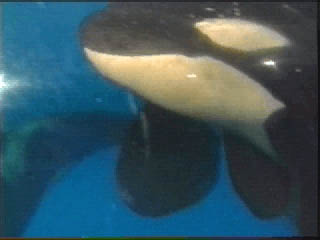
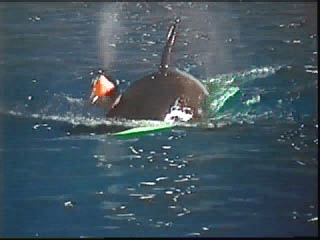
Above Kasatka brings her calf up for his first breath.

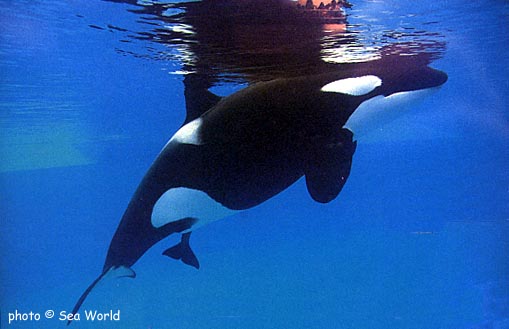
Kasatka gives birth to Takara above.
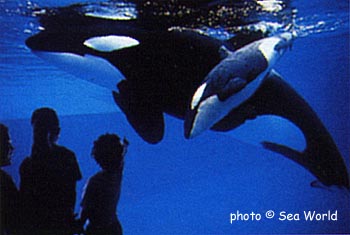
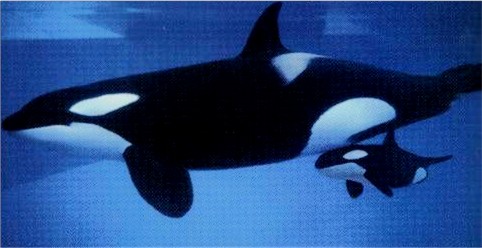
Kasatka with her first calf Takara.
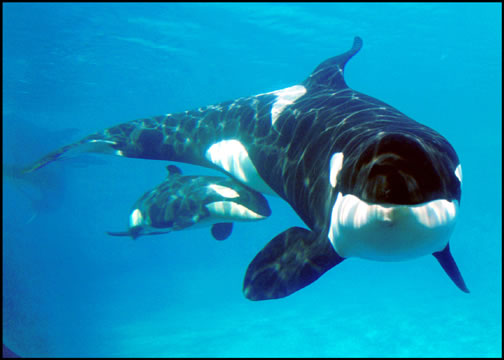
Above is Katina with her newest calf.
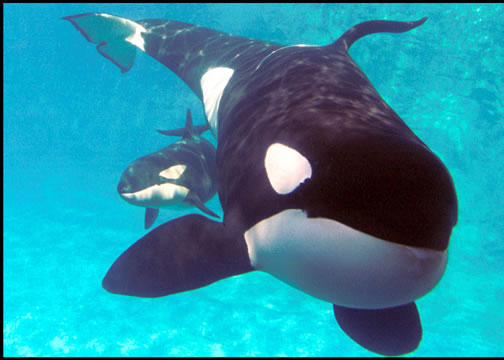
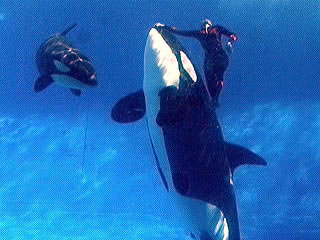
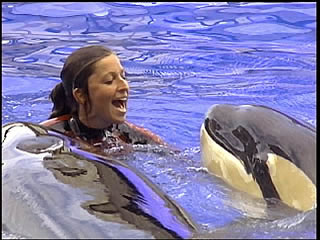
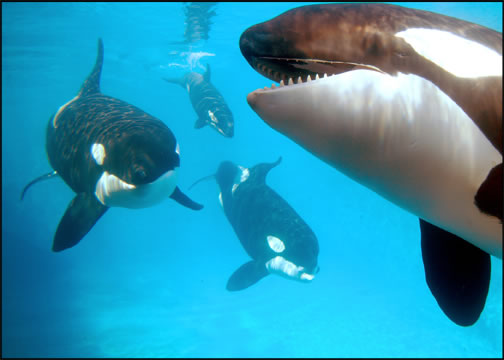
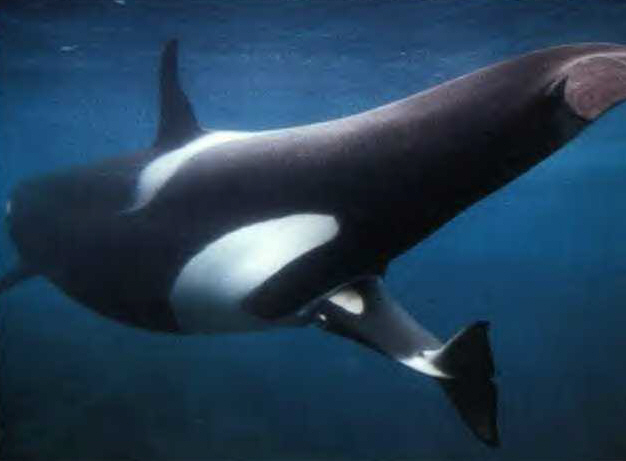
When the calf is born it swims in moms slip stream to get a free ride and allow it to rest. The calf is alight tan in color when born with patchy gray spots on its black body that sloth off as it grows. The dorsal fin is floppy from being in the womb and the rings around the calf which are called fetal folds are also from being in the womb. Within the next few months as the calf grows and stretches out the fetal folds disappear and the dorsal fin straightens out. Below shows an orca under its mother. The dorsal fin and fetal folds have disppeared.





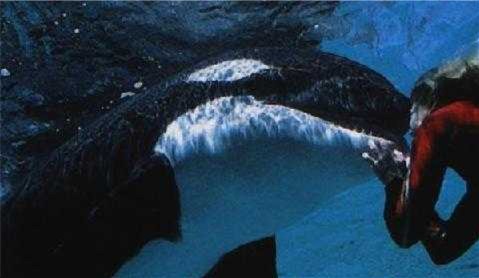
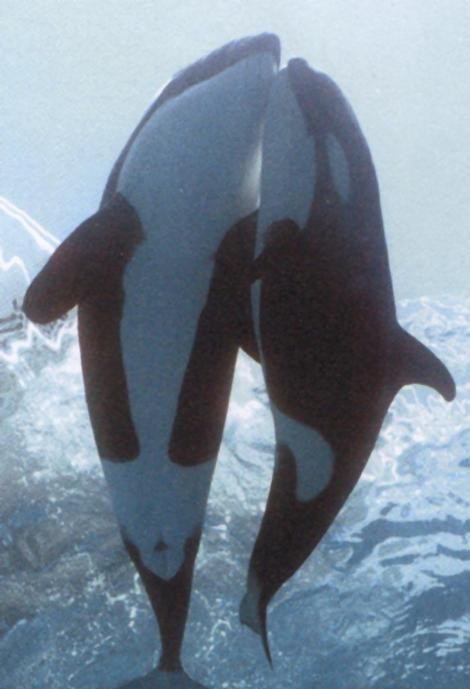
Above picture is Katina with young Kalina.
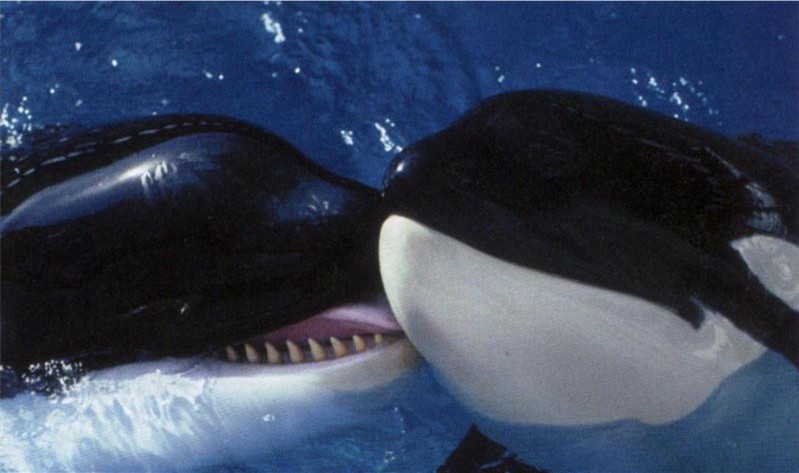
Katina gives her baby a kiss.
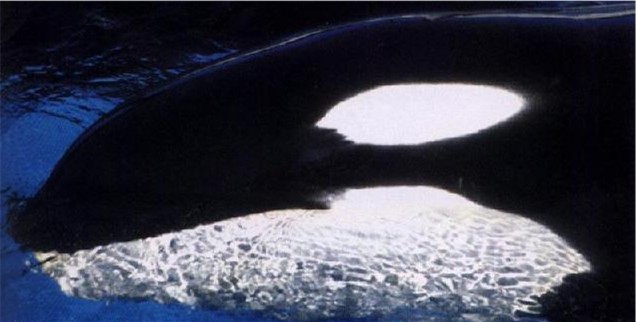
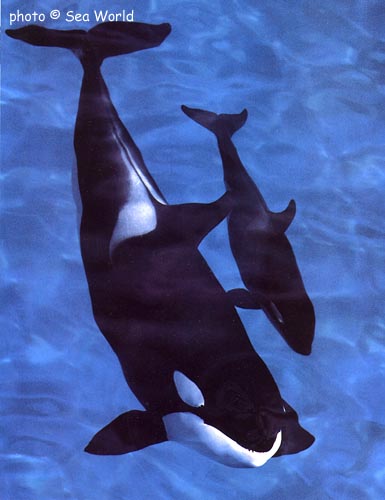
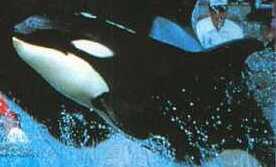

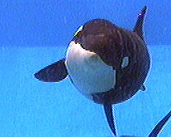
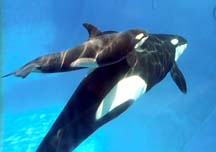
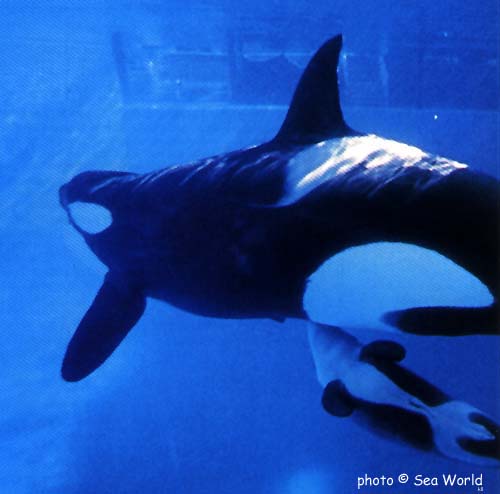
An orca calf will nurse only 5 - 10 seconds several times an hour. Mom's milk is as thick as ice cream and high in fat so the calf gains weight and grows quickly. The baby wraps its tongue around the teet like a straw to suckle mom's milk. Kalina is known to wean her calves very quickly. She teaches them to eat fish and stop nursing at a very young age.

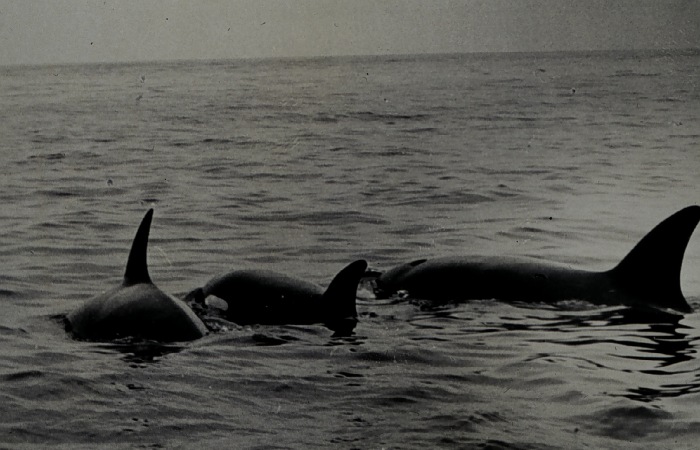
Wild orcas are born the same, nurse the same and learn from mom just as captive orca calves do. Orcas stay with there moms there whole lives in live in a pod with aunts, grandparents, brothers and sisters. They travel hundreds of miles a day. There bonds are very close and they are the most social mammal in the animal kingdom. When calves are born they are taught how to hunt and live in orca society and how to survive when there older just as humans are. It is not instinct as it is with other animals but learned behavior. A young newborn calf without other orcas will die without a mother to teach it survival skills.
Kasatka shown with her daughter Takara also known as "Tiki" at Sea World of California in San Diego.

Getting bigger every day!
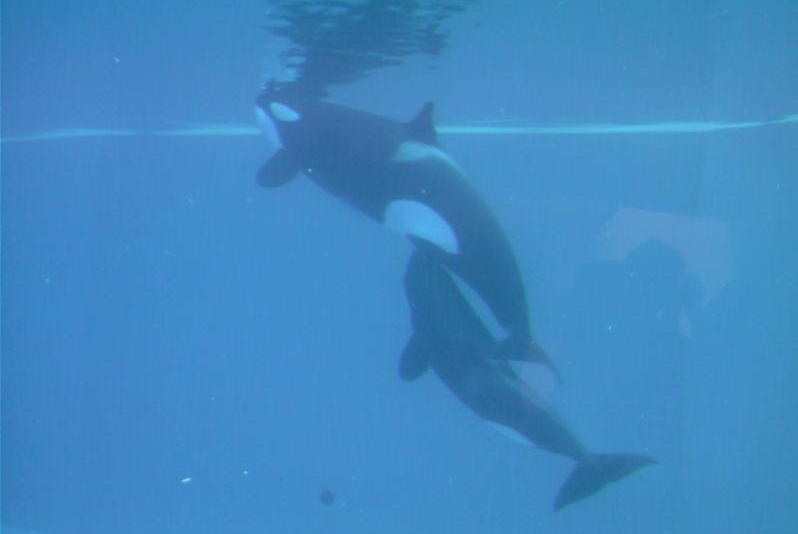

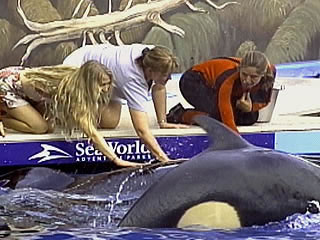

Katina's newest calf is already watching and learning from mom in the Shamu Adventure show!
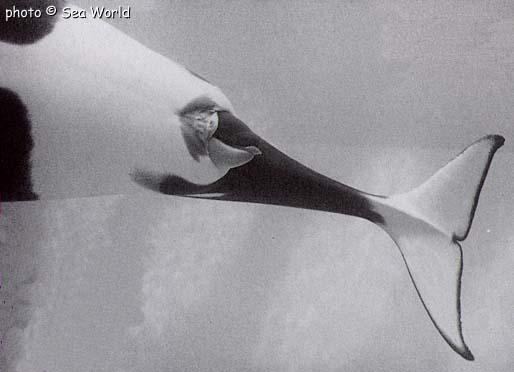
Sea World of California's "Orkid" although risky is born head first.

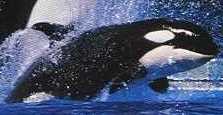
Baby Orkid
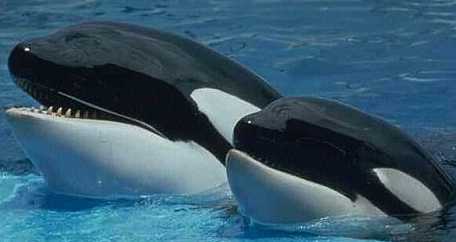
Kona and young Kalina
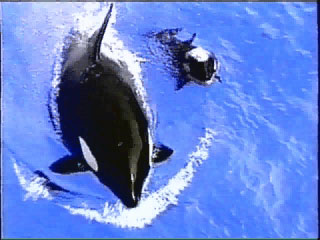
HOME